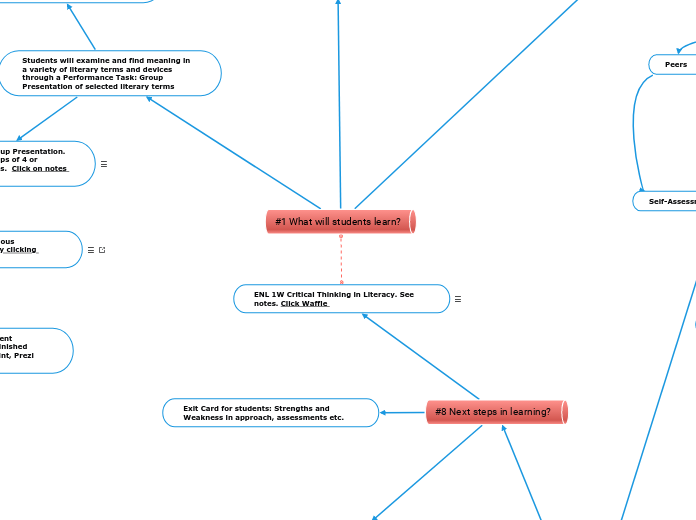
New curriculum Strand C. Comprehension: Understanding and Responding to TextsC3. Critical Thinking in LiteracyLiterary Devices C3.1 analyze literary devices, including allusion, analogy, juxtaposition, and flashback, in a variety of texts, and explain how they help create meaning and are appropriate for the intended purpose and audience, (curriculum documents)
Assignment: Each group member picks 2 or 3 literary devicesProvide a definition. Use a reliable source. Provide a reference.Rewrite the definition in your own words. Use your definition from #1, with additional definitions to help you from your own. Provide references.Two Passages: 1- write a passage WITHOUT any figurative language or comparisons. 2- write a passage using the literary device correctly. This passage uses the device effectively by providing a comparison.Present info from #1-3 to class in 5 minute presentation
Examination of exemplars of student work at varying levels of proficiency provides an opportunity for students to think critically about their own work, measure it against the standard and set about to make adjustments to improve the quality of their work, (p.g 10 Assessment in Alberta: Discussion paper) Alberta Education. Assessment in Alberta: Supporting student learning, guiding instruction. Retrieved from https://www.learnalberta.ca/content/ssass/html/pdf/assessment_in_alberta.pdf
aThe checklist becomes a powerful learning tool when students take time to make the necessary improvements prior to submitting their final group project for grading, (p.g 26 Assessment in Alberta: Discussion paper)Alberta Education. Assessment in Alberta: Supporting student learning, guiding instruction. Retrieved from https://www.learnalberta.ca/content/ssass/html/pdf/assessment_in_alberta.pdf
aThe inclusion of compliments amid critiques allows students to listen to feedback with an open mind that is less guarded,” (Sieben, 2017).
Students will form new groups and share their definitions and passages with other students (students from different groups). Teacher will model how students peer evaluate one another via a Student Rating Scale or a Checklist designed by the teacher. Students will help each other by reviewing how the literary term is used in the passage. More exposure to literary terms will help students study for their Literary Terms quiz and help them fine-tune their group project
Students should demonstrate some real-life connections or an application link to the "enduring understandings" (Wiggins and McTighe, 1998) of the performance task. When students bring in their own songs that use Literary Terms they are not only getting instant feedback themselves; they are also taking ownership of their own learning. Wiggins, G. & McTighe, J. (2005). Understanding by Design, 2nd Ed. Alexandria, VA: Association for Supervision and Curriculum Development.
Students will receive constant feedback from the teacher and their classmates. The teacher will collect and provide evidence of learning by reviewing students notebooks with their written responses to poems/songs and their journals.
Criterion-based feedback will occur as the teacher will review the
I will have a lot of time to conference with the students, as there are responding to questions on poems/songs or researching for their Performance Task. While this is occurring I can provide ongoing verbal feedback. Stagg Peterson (2010) argues that verbal and written feedback can be a “powerful teaching tool if it is given while students are in the process of writing drafts” (p. 1). Although my students are not writing a draft for an essay, they still are crafting their passages for the Performance Task. I can provide feedback about “timely information, ” - how literary terms enhance meaning. This is an 'immediate need' for students as they are crafting their passages. Stagg Peterson, S. (2010). Improving student writing using feedback as a teaching tool. What works? Research in Practice, 29. Queen’s Printer for Ontario. http://www. edu.gov.on.ca/eng/literacynumeracy/inspire/research/WW_Improving_Student_Writing.pdf
a